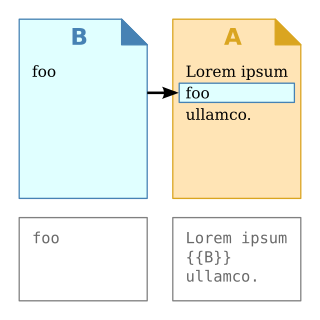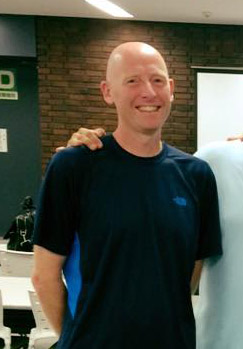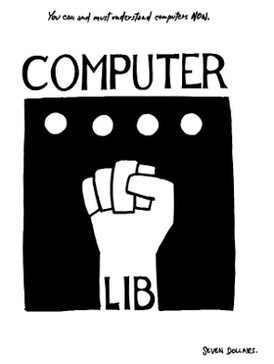Related Research Articles

Hypertext is text displayed on a computer display or other electronic devices with references (hyperlinks) to other text that the reader can immediately access. Hypertext documents are interconnected by hyperlinks, which are typically activated by a mouse click, keypress set, or screen touch. Apart from text, the term "hypertext" is also sometimes used to describe tables, images, and other presentational content formats with integrated hyperlinks. Hypertext is one of the key underlying concepts of the World Wide Web, where Web pages are often written in the Hypertext Markup Language (HTML). As implemented on the Web, hypertext enables the easy-to-use publication of information over the Internet.

In computer science, transclusion is the inclusion of part or all of an electronic document into one or more other documents by reference via hypertext. Transclusion is usually performed when the referencing document is displayed, and is normally automatic and transparent to the end user. The result of transclusion is a single integrated document made of parts assembled dynamically from separate sources, possibly stored on different computers in disparate places.

Memex is a hypothetical electromechanical device for interacting with microform documents and described in Vannevar Bush's 1945 article "As We May Think". Bush envisioned the memex as a device in which individuals would compress and store all of their books, records, and communications, "mechanized so that it may be consulted with exceeding speed and flexibility". The individual was supposed to use the memex as an automatic personal filing system, making the memex "an enlarged intimate supplement to his memory". The name memex is a portmanteau of memory and expansion.

Theodor Holm Nelson is an American pioneer of information technology, philosopher, and sociologist. He coined the terms hypertext and hypermedia in 1963 and published them in 1965. According to a 1997 Forbes profile, Nelson "sees himself as a literary romantic, like a Cyrano de Bergerac, or 'the Orson Welles of software'."
Project Xanadu was the first hypertext project, founded in 1960 by Ted Nelson. Administrators of Project Xanadu have declared it superior to the World Wide Web, with the mission statement: "Today's popular software simulates paper. The World Wide Web trivialises our original hypertext model with one-way ever-breaking links and no management of version or contents."
Information architecture (IA) is the structural design of shared information environments; the art and science of organizing and labelling websites, intranets, online communities and software to support usability and findability; and an emerging community of practice focused on bringing principles of design, architecture and information science to the digital landscape. Typically, it involves a model or concept of information that is used and applied to activities which require explicit details of complex information systems. These activities include library systems and database development.
This article presents a timeline of hypertext technology, including "hypermedia" and related human–computer interaction projects and developments from 1945 on. The term hypertext is credited to the author and philosopher Ted Nelson.

Digital poetry is a form of electronic literature, displaying a wide range of approaches to poetry, with a prominent and crucial use of computers. Digital poetry can be available in form of CD-ROM, DVD, as installations in art galleries, in certain cases also recorded as digital video or films, as digital holograms, on the World Wide Web or Internet, and as mobile phone apps.
Findability is the ease with which information contained on a website can be found, both from outside the website and by users already on the website. Although findability has relevance outside the World Wide Web, the term is usually used in that context. Most relevant websites do not come up in the top results because designers and engineers do not cater to the way ranking algorithms work currently. Its importance can be determined from the first law of e-commerce, which states "If the user can’t find the product, the user can’t buy the product." As of December 2014, out of 10.3 billion monthly Google searches by Internet users in the United States, an estimated 78% are made to research products and services online.

Peter Morville is president of Semantic Studios, an information architecture and findability consulting firm. He may be best known as an influential figure and "founding father" of information architecture, having coauthored the best-selling book in the discipline, Information Architecture for the World Wide Web. For over a decade, he has advised such clients as AT&T, Dow Chemical, Ford, the IMF, the Library of Congress, and Microsoft. Morville was a co-founder and past president of the Information Architecture Institute, and has served on their advisory board. He delivers keynotes and seminars at international events, and his work has been featured in major publications, including Business Week, Fortune, and The Wall Street Journal.

In information systems, a tag is a keyword or term assigned to a piece of information. This kind of metadata helps describe an item and allows it to be found again by browsing or searching. Tags are generally chosen informally and personally by the item's creator or by its viewer, depending on the system, although they may also be chosen from a controlled vocabulary.

Computer Lib/Dream Machines is a 1974 book by Ted Nelson, printed as a two-front-cover paperback to indicate its "intertwingled" nature. Originally self-published by Nelson, it was republished with a foreword by Stewart Brand in 1987 by Microsoft Press.
Roger Everett Gregory is a US computer programmer, technologist, and scientist. Gregory's work in project Xanadu made him one of the earliest pioneers of hypertext technology, which helped lay the foundations for the hyperlink technology that underlies the World Wide Web. Gregory attended the University of Michigan as a mathematics major. In the 1970s, he founded the Ann Arbor Computer Club, similar to the West Coast's Home Brew Computer Club.
Hyperland is a 50-minute-long documentary film about hypertext and surrounding technologies. It was written by Douglas Adams and produced and directed by Max Whitby for BBC Two in 1990. It stars Douglas Adams as a computer user and Tom Baker, with whom Adams had already worked on Doctor Who, as a personification of a software agent.
The concept of the Social Semantic Web subsumes developments in which social interactions on the Web lead to the creation of explicit and semantically rich knowledge representations. The Social Semantic Web can be seen as a Web of collective knowledge systems, which are able to provide useful information based on human contributions and which get better as more people participate. The Social Semantic Web combines technologies, strategies and methodologies from the Semantic Web, social software and the Web 2.0.

David Weinberger is an American author, technologist, and speaker. Trained as a philosopher, Weinberger's work focuses on how technology — particularly the internet and machine learning — is changing our ideas, with books about the effect of machine learning’s complex models on business strategy and sense of meaning; order and organization in the digital age; the networking of knowledge; the Net's effect on core concepts of self and place; and the shifts in relationships between businesses and their markets.

Glut: Mastering Information Through The Ages is a 2007 book written by Alex Wright, a writer and information architect for The New York Times. Wright's intention is to provide a broad historical overview of the development of information transmission and organization systems.

Hypertext is text displayed on a computer or other electronic device with references (hyperlinks) to other text that the reader can immediately access, usually by a mouse click or keypress sequence. Early conceptions of hypertext defined it as text that could be connected by a linking system to a range of other documents that were stored outside that text. In 1934 Belgian bibliographer, Paul Otlet, developed a blueprint for links that telescoped out from hypertext electrically to allow readers to access documents, books, photographs, and so on, stored anywhere in the world.
Wirearchy is the power structure created as the Information Age unfolded, disrupting hierarchical organizations and the fundamental construct of access to knowledge. In earlier eras, when information was scarce and access to information was power, organizations structured themselves along chains of power and authority, with those higher in the organization having more knowledge and therefore more power. These structures disintegrated as the Internet made a huge spectrum of information and knowledge freely available.
Are.na is an online social networking community and creative research platform founded by Charles Broskoski, Daniel Pianetti, Chris Barley, and Chris Sherron. Are.na was built as a successor to hypertext projects like Ted Nelson's Xanadu, and as an ad-free alternative to social networks like Facebook, forgoing "likes," "favorites," or "shares" in its design. Are.na allows users to compile uploaded and web-clipped "blocks" into different "channels," and has been described as a "vehicle for conscious Internet browsing," "playlists, but for ideas," and a "toolkit for assembling new worlds."
References
- ↑ Nelson, Theodor (1974), Computer Lib: You can and must understand computers now/Dream Machines: New freedoms through computer screens—a minority report (1st ed.), South Bend, IN: the distributors, ISBN 0-89347-002-3
- ↑ Nelson, Theodor (1987), Computer Lib/Dream Machines (Rev. ed.), Redmond, WA: Tempus Books of Microsoft Press, ISBN 0-914845-49-7
- ↑ F., G. (June 17, 2014). "A Kubla Khan-do attitude". The Economist. Retrieved August 15, 2015.
- ↑ Morville, Peter (2005-09-26). Ambient Findability: What We Find Changes Who We Become. "O'Reilly Media, Inc.". pp. 64–65. ISBN 9780596553012.
- ↑ Morville, Peter. "Intertwingled". Intertwingled. Retrieved 2015-08-12.
- ↑ Weinberger, David (2008-04-29). Everything Is Miscellaneous: The Power of the New Digital Disorder. Macmillan. pp. 125–128. ISBN 9780805088113 . Retrieved 2015-08-11.
- ↑ Dechow, Douglas (2014-04-18). "Intertwingled: The Work and Influence of Ted Nelson". The Huffington Post. Retrieved 2015-08-12.
- ↑ "Intertwingled: The Work and Influence of Ted Nelson". Chapman University. Retrieved 2015-08-12.
- ↑ Intertwingled - The Work and Influence of Ted Nelson. Springer. Retrieved 2015-08-11.
- ↑ Hamilton, Ian (April 25, 2014). "'Intertwingled' at Chapman muses on how Web could have been". The Orange County Register. Retrieved August 15, 2015.